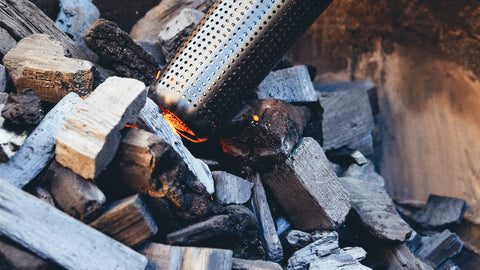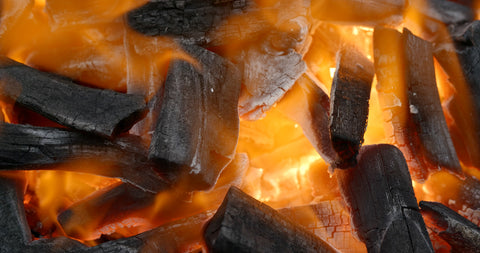How Long Does Charcoal Last?
Concisely, lump charcoal lasts around 45 minutes in an average grill and between three to four hours in a smoker. But there’s more to consider. The grill layout and the type of charcoal significantly impact its duration.
Anyone can flip a few burgers on the grill but mastering the art of grilling takes time and patience. There’s so much to learn! And talking about time, charcoal is one of those variables you want to control. The charcoal’s temperature and duration ultimately determine how long you need to cook your meaty goodies for the best results, and that’s something not to be underestimated.
Let’s talk about charcoal. How long does charcoal take to burn out? How long does charcoal stay hot? Here’s all you need to know. Master those embers, and you’ll level up your grilling game. After your choice of meat, of course, the decisions you make around charcoal determine the success of your grilling session, so let’s get to it.

This is charcoal 101 and we’re covering the most frequent doubts but reach out if you still have questions about charcoal burnout times after reading this! Let’s make this grill-loving community grow!
How Long Does Charcoal
Let’s explore the time it takes for charcoal to burn out, how long does it stay hot and how long it takes to heat up. Understanding these three stages is an excellent way to improve your grilling skills.
1. Take to Burn Out
There’s no doubt you don’t want your fire to die off in the middle of the evening and bringing it back to life is not all that easy. That’s why knowing how long it takes for charcoal to burn out is paramount.
Standard lump charcoal lasts around 45 minutes if working on an open grill. The coal will remain lit for over an hour, but it won’t produce high heat anymore. This, of course, depends on the size of the lumps and their condition. A backyard grilling party usually lasts around two hours of active grilling time, so have extra coal in hand. Chances are you’ll have to replenish the grill at least once.
In a smoker or a closed grill, charcoal will last much more, up to four hours, and it’s because it has less oxygen and burns at a slower rate. What about briquettes? Depending on their quality, they’ll last significantly longer than lump charcoal. Expect the first batch to last up to four hours in an open grill, although wood and coal briquettes can burn up to 12 hours.
Expect coconut briquettes to last around two hours, but these times are subjective. The charcoal or briquette layout, their quality and composition, the size and shape of the grill and even the environment play a role in the life expectancy of your fire. Still, these guidelines give you an idea of what to expect and what type of charcoal you want to use.
2. Stay Hot
How long does charcoal stay hot? This is perhaps more important than the time it takes for the charcoal to burn out. After all, you want not only lit charcoal; you want it hot enough to cook your food evenly and efficiently. And to keep it lit.
Typically, once lit, the charcoal already produces cooking temperatures after only ten minutes. This is the right time to cook any food that requires high temperatures, like thick steaks and starchy vegetables.
After 25 minutes, the charcoal will produce medium heat, which is better for white meat like chicken and fish. Don’t expect to cook a thick ribeye to well-done temperatures, that, of course, unless you stoke the coal a little or replenish the burned-out coals.
Between 30 and 45 minutes, your grill will now produce low heat, best suited for hot dogs and delicate veggies like asparagus. It’s time to think about replenishing the charcoal. Then again, if you timed your cooking right, you’ve already grilled the thicker cuts, the white meat at the veggies, all at the right time.
Setting up two temperature zones on the grill is a common and valuable technique that allows you to cook different foods simultaneously. You can achieve this by using larger lump charcoals on one side of the grill and smaller ones on the other, which will become the cooler side. Adding a few fresh coals to the grill after the twenty-minute mark will also help you keep an adequate cooking temperature for longer.

3. Take to Heat Up
Charcoal generally reaches its highest temperature at the ten-minute mark. If you’re not getting hot enough temperatures for cooking, some tips can help you increase the temperature a bit.
For starters, consider investing in an iron grate. The grate’s material greatly influences the temperature of the surface in touch with your food. If you just bought a grill, chances are your grate is made of iron, which is less conductive.
Another easy technique consists of lowering the grate a notch. The closer the food is to the embers, the higher the temperature. Even an inch can cause a significant difference in your grilling temperatures and cooking times.
Then there is the obvious choice, our Looft fire starter.
Talking about charcoal, you’ll get the highest temperatures with fresh lump charcoal. Make sure the coal is all of a similar size and that it’s not moldy or damp. Also, avoid using old charcoal, as it might not reach temperatures as high as the fresh stuff.
Other standard techniques that will help you increase the grill temperature are closing the lid, opening the vents or dampers, and making sure no coals are obstructing the bottom vents.
If all the above fails, consider cooking your thicker cuts and tougher veggies within the first ten minutes of grilling, when the coals are hotter, which leads us to the final tip.
Ensure all the coals are lit evenly. For that, a Looft lighter works beautifully, as it lights up the charcoal evenly in just a minute, literally, and you can get grilling right away.
How to Make Charcoals Last Longer
There’s no easy way to make charcoals last longer. After all, we’re talking about fuel, and fuel burns out. If you time your grilling session correctly, you need not make charcoals last longer, but if you unexpectedly need to make those lumps last a few more minutes, some techniques might help.
Arranging the coal in specific ways will make it last longer, like in the famous charcoal snake or ring of fire, where you only light a few coals and let them light the rest one at a time. Watch out for the temperatures, though; it might take up to an hour for your grill to reach high grilling temperatures.
You can also use higher-quality charcoal that naturally lasts longer, like the Japanese binchotan, which can burn for up to five hours at high heat. After binchotan, briquettes are your best bet.
Avoiding overcrowding the grill with coal is a good way of extending its burning life, so place the charcoal in an even layer. And whatever you do, avoid using lighter fluid that speeds up the coals’ natural burning times.
Monitor your fuel at all times and close the vents gradually as you grill. Keep the lid closed when possible, and don’t worry if your coal doesn’t last that long; nothing lasts forever, and replenishing your fuel is part of grilling!

Tips/Techniques for Using Charcoal
- Always use fresh charcoal. The old charcoal you have in the shed is probably moist and moldy. Get a new batch every time you plan to light up the grill.
- Choose your charcoal wisely. Lump charcoal and briquettes have different uses. You don’t have to choose one over the other. Use what’s best for the moment.
- For charcoal, quality matters. Cheap briquettes burn too fast, and low-quality lump charcoal is often uneven and probably too old. Get the good stuff!
- Preheat. Preheat the grate before placing your food. Allow the grill to reach high-enough temperatures before cooking. Ten minutes is usually enough.
- Work those vents. Open and close the vents of dampers to control the grill’s temperature. You’ll also extend the fuel’s burning life.
- Build a two-fire zone grill. This gives you versatility and a greater opportunity to cook everything faster.
- No more lighter fluid. Forget about lighting fluid; it will ruin your food. Use an efficient lighting system like the Looft lighter instead.
- Indirect heat is your friend. Not everything must be cooked over blistering embers. Use the grill’s edges for cooking more delicate food if you didn’t build a two-fire zone grill.
- Keep the small bits safe. Use a grill pan for cooking smaller veggies and forgetting about watching them fall into the burning coals.
- Consider the altitude. Cooking times are longer and temperatures lower at high altitudes and colder climates, so keep that in mind.
- Use thermometers. Make sure you have two thermometers, one to measure the grill’s temperature and a meat thermometer to make sure the meat is always at the perfect doneness.
- Goodbye flare-ups. If experiencing too many flare-ups, open the lid for a while to lower the grill’s temperature a bit.
- Flip once. When cooking over charcoal, flip the food only once. Make sure you get that lovely thick crust and use your thermometer to ensure the core temperature is exactly right.
- Safety first. Ensure you have tongs and other long tools to manage the food safely.
- Don’t rush it. Low and slow is often the way to go. Don’t get overly excited and give your food time to charr and cook correctly.
- The looks matter. Have the food presentation on your mind. Try to grill food as beautiful as it is tasty. Use the grate to mark your steaks evenly for restaurant-quality meals.
What To Do With Charcoal After Grilling
After a long grilling session, you’ll end with two things, a satisfied crowd and a whole bunch of spent charcoal. There are ways of making the most out of charcoal after grilling, so your work is not done yet. Here are some ideas.
Reuse the charcoal. Yes, you can reuse charcoal as long as it’s not entirely burned out. Don’t pour water into the charcoal, or you’ll damage it irreparably. Instead, spray it with a bit of water to extinguish the flame. You’ll be able to use it in your next grilling session.
Use the charcoal as fertilizer. Charcoal is good for your lawn and plants, especially if you don’t use lighter fluid. Potassium carbonate in the coal is highly nutritious for plants.
Charcoal absorbs odors. Store spent charcoal in a mesh pouch and place it wherever you have bad smell problems or excess moisture, like in your cellar, shed or basement, for example. Charcoal can take care of all your moisture problems.
Keep bugs away. Powdered charcoal can keep some insects at bay. Just spread it wherever you have a pest problem. The best part? Charcoal is all-natural, so forget about harmful pesticides.
Final Thoughts
Grilling is tons of fun, and the more you do it, the better you’re at it. Charcoal is a critical element in grilling and offers an entirely different and more primal experience than what you get from a gas grill.
Charcoal comes in all shapes and sizes and learning how to master the different types is immensely important if you want to get better at grilling. And don’t worry, we all have charcoal trouble sometimes, whether we’re not reaching the correct cooking temperatures or running out of fuel. It happens, and that’s okay.
Keep on grilling and use the information in this guide to feel more confident when charcoal grilling. At the end of the day, we’re the ones stepping up in front of the grill for a reason — we love that feeling! Not everyone can take the heat.
Whatever you do, don’t stop grilling (and don’t let anyone else take your place in front of the grill.) You’ll become a charcoal-grilling master in no time. No lump will be a match against your skills, and that’s the kind of success we wish for you. Let’s get that fire started and get grillin’!



